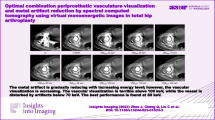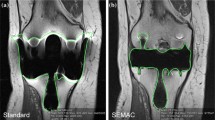Abstract
Purpose
This study evaluates the image quality of lower extremity CT venography reconstructed with orthopedic metal artifact reduction (O-MAR) in patients with unilateral or bilateral metallic prostheses in the hip or knee.
Methods
This retrospective study was approved by our institutional review board, and informed consent was waived. Twenty-nine patients of lower extremity CT with 51 metallic hip or knee prostheses were reconstructed to both standard CT images and O-MAR images. The subjective image quality and vessel conspicuity for both images were evaluated by two readers using five-point scales (0–4). Vessel conspicuity scores of 3 or 4 were considered diagnostically acceptable. Image noise was measured in the air and subcutaneous fat.
Results
O-MAR images showed significantly higher scores of subjective image quality (p < .001) and vessel conspicuity (p = .002) than standard CT images. Diagnostic acceptance of vessel conspicuity was not significantly different between O-MAR images and standard CT images (p = 1.000). O-MAR images showed significantly less image noise than conventional CT images (p < .001 for both air and subcutaneous fat).
Conclusion
O-MAR may be an effective solution for the metal artifacts in lower extremity CT venography; however, the distance between prostheses and vessels affects the diagnostic acceptance in patients with metallic hip or knee prostheses.
Level of Evidence
Level 4, Case Series.



Similar content being viewed by others
References
Birrell F, Johnell O, Silman A. Projecting the need for hip replacement over the next three decades: influence of changing demography and threshold for surgery. Ann Rheum Dis. 1999;58(9):569–72.
Januel JM, Chen G, Ruffieux C, Quan H, Douketis JD, Crowther MA, et al. Symptomatic in-hospital deep vein thrombosis and pulmonary embolism following hip and knee arthroplasty among patients receiving recommended prophylaxis: a systematic review. JAMA. 2012;307(3):294–303. https://doi.org/10.1001/jama.2011.2029.
Buckwalter KA, Lin C, Ford JM. Managing postoperative artifacts on computed tomography and magnetic resonance imaging. Semin Musculoskelet Radiol. 2011;15(4):309–19. https://doi.org/10.1055/s-0031-1286013.
Barrett JF, Keat N. Artifacts in CT: recognition and avoidance. Radiograph Rev Publ Radiol Soc North Am. 2004;24(6):1679–91. https://doi.org/10.1148/rg.246045065.
Lee MJ, Kim S, Lee SA, Song HT, Huh YM, Kim DH, et al. Overcoming artifacts from metallic orthopedic implants at high-field-strength MR imaging and multi-detector CT. Radiograph Rev Publ Radiol Soc North Am. 2007;27(3):791–803. https://doi.org/10.1148/rg.273065087.
Boas FE, Fleischmann D. Evaluation of two iterative techniques for reducing metal artifacts in computed tomography. Radiology. 2011;259(3):894–902. https://doi.org/10.1148/radiol.11101782.
Cronin CG, Lohan DG, Keane M, Roche C, Murphy JM. Prevalence and significance of asymptomatic venous thromboembolic disease found on oncologic staging CT. Am J Roentgenol. 2007;189(1):162–70. https://doi.org/10.2214/AJR.07.2067.
Ghaye B, Szapiro D, Willems V, Dondelinger RF. Pitfalls in CT venography of lower limbs and abdominal veins. AJR Am J Roentgenol. 2002;178(6):1465–71. https://doi.org/10.2214/ajr.178.6.1781465.
Bamberg F, Dierks A, Nikolaou K, Reiser M, Becker C, Johnson TC. Metal artifact reduction by dual energy computed tomography using monoenergetic extrapolation. Eur Radiol. 2011;21(7):1424–9. https://doi.org/10.1007/s00330-011-2062-1.
Mumoli N, Vitale J, Cocciolo M, Cei M, Brondi B, Basile V, et al. Accuracy of nurse-performed compression ultrasonography in the diagnosis of proximal symptomatic deep vein thrombosis: a prospective cohort study. J Thromb Haemost JTH. 2014;12(4):430–5. https://doi.org/10.1111/jth.12522.
Glover GH, Pelc NJ. An algorithm for the reduction of metal clip artifacts in CT reconstructions. Med Phys. 1981;8(6):799–807.
Wang G, Snyder DL, O'Sullivan JA, Vannier MW. Iterative deblurring for CT metal artifact reduction. IEEE Trans Med Imaging. 1996;15(5):657–64. https://doi.org/10.1109/42.538943.
Yasaka K, Maeda E, Hanaoka S, Katsura M, Sato J, Ohtomo K. Single-energy metal artifact reduction for helical computed tomography of the pelvis in patients with metal hip prostheses. Jpn J Radiol. 2016;34(9):625–32.
Kidoh M, Nakaura T, Nakamura S, Tokuyasu S, Osakabe H, Harada K, et al. Reduction of dental metallic artefacts in CT: value of a newly developed algorithm for metal artefact reduction (O-MAR). Clin Radiol. 2014;69(1):e11–6. https://doi.org/10.1016/j.crad.2013.08.008.
Morsbach F, Bickelhaupt S, Wanner GA, Krauss A, Schmidt B, Alkadhi H. Reduction of metal artifacts from hip prostheses on CT images of the pelvis: value of iterative reconstructions. Radiology. 2013;268(1):237–44. https://doi.org/10.1148/radiol.13122089.
Shinohara Y, Sakamoto M, Iwata N, Kishimoto J, Kuya K, Fujii S, et al. Usefulness of monochromatic imaging with metal artifact reduction software for computed tomography angiography after intracranial aneurysm coil embolization. Acta Radiol. 2014;55(8):1015–23. https://doi.org/10.1177/0284185113510492.
Sunwoo L, Park S-W, Rhim JH, Kang Y, Chung YS, Son Y-J, et al. Metal artifact reduction for orthopedic implants: brain CT angiography in patients with intracranial metallic implants. J Korean Med Sci. 2018;33(21):e158. https://doi.org/10.3346/jkms.2018.33.e158.
Kidoh M, Utsunomiya D, Oda S, Nakaura T, Funama Y, Yuki H, et al. CT venography after knee replacement surgery: comparison of dual-energy CT-based monochromatic imaging and single-energy metal artifact reduction techniques on a 320-row CT scanner. Acta Radiol Open. 2017;6(2):2058460117693463. https://doi.org/10.1177/2058460117693463.
Katsura M, Sato J, Akahane M, Kunimatsu A, Abe O. Current and novel techniques for metal artifact reduction at CT: practical guide for radiologists. Radiograph Rev Publ Radiol Soc North Am. 2018;38(2):450–61. https://doi.org/10.1148/rg.2018170102.
Yu L, Li H, Mueller J, Kofler JM, Liu X, Primak AN, et al. Metal artifact reduction from reformatted projections for hip prostheses in multislice helical computed tomography: techniques and initial clinical results. Investig Radiol. 2009;44(11):691–6. https://doi.org/10.1097/RLI.0b013e3181b0a2f9.
Lubner MG, Pickhardt PJ, Tang J, Chen GH. Reduced image noise at low-dose multidetector CT of the abdomen with prior image constrained compressed sensing algorithm. Radiology. 2011;260(1):248–56. https://doi.org/10.1148/radiol.11101380.
Qi L, Meinel FG, Zhou CS, Zhao YE, Schoepf UJ, Zhang LJ, et al. Image quality and radiation dose of lower extremity CT angiography using 70 kVp, high pitch acquisition and sinogram-affirmed iterative reconstruction. PloS One. 2014;9(6):e99112. https://doi.org/10.1371/journal.pone.0099112.
Metal Artifact Reduction for Orthopedic Implants (O-MAR). Philips CT Clinical Science. 2012. https://clinical.netforum.healthcare.philips.com/us_en/Explore/White-Papers/CT/Metal-Artifact-Reduction-for-Orthopedic-Implants-(O-MAR). Accessed 1 Dec 2018.
Byun SS, Kim JH, Kim YJ, Jeon YS, Park CH, Kim WH. Evaluation of deep vein thrombosis with multidetector row CT after orthopedic arthroplasty: a prospective study for comparison with Doppler sonography. Korean J Radiol Off J Korean Radiol Soc. 2008;9(1):59–66. https://doi.org/10.3348/kjr.2008.9.1.59.
Cogo A, Lensing AW, Prandoni P, Hirsh J. Distribution of thrombosis in patients with symptomatic deep vein thrombosis Implications for simplifying the diagnostic process with compression ultrasound. Arch Intern Med. 1993;153(24):2777–80.
Hirsh J, Lee AY. How we diagnose and treat deep vein thrombosis. Blood. 2002;99(9):3102–10.
Coupal TM, Mallinson PI, McLaughlin P, Nicolaou S, Munk PL, Ouellette H. Peering through the glare: using dual-energy CT to overcome the problem of metal artefacts in bone radiology. Skelet Radiol. 2014;43(5):567–75. https://doi.org/10.1007/s00256-013-1802-5.
Yue D, Fan Rong C, Ning C, Liang H, Ai Lian L, Ru Xin W, et al. Reduction of metal artifacts from unilateral hip arthroplasty on dual-energy CT with metal artifact reduction software. Acta Radiol. 2018;59(7):853–60. https://doi.org/10.1177/0284185117731475.
Boudabbous S, Arditi D, Paulin E, Syrogiannopoulou A, Becker C, Montet X. Model-based iterative reconstruction (MBIR) for the reduction of metal artifacts on CT. Am J Roentgenol. 2015;205(2):380–5. https://doi.org/10.2214/AJR.14.13334.
Wellenberg RHH, Hakvoort ET, Slump CH, Boomsma MF, Maas M, Streekstra GJ. Metal artifact reduction techniques in musculoskeletal CT-imaging. Eur J Radiol. 2018;107:60–9. https://doi.org/10.1016/j.ejrad.2018.08.010.
Funding
This study was not supported by any funding.
Author information
Authors and Affiliations
Corresponding author
Ethics declarations
Conflict of interest
The authors declare that they have no conflict of interest.
Human and Animal Participants
All procedures performed in studies involving human participants were in accordance with the ethical standards of the institutional and/or national research committee and with the 1964 Helsinki Declaration and its later amendments or comparable ethical standards.
Ethical Approval
This study has obtained IRB approval from SMG-SNU Boramae medical center and the need for informed consent was waived.
Additional information
Publisher's Note
Springer Nature remains neutral with regard to jurisdictional claims in published maps and institutional affiliations.
Electronic supplementary material
Below is the link to the electronic supplementary material.
Rights and permissions
About this article
Cite this article
Woo, H., Chai, J.W., Choi, Y.H. et al. Metal Artifact Reduction for Orthopedic Prosthesis in Lower Extremity CT Venography: Evaluation of Image Quality and Vessel Conspicuity. Cardiovasc Intervent Radiol 42, 1619–1626 (2019). https://doi.org/10.1007/s00270-019-02326-2
Received:
Revised:
Accepted:
Published:
Issue Date:
DOI: https://doi.org/10.1007/s00270-019-02326-2




